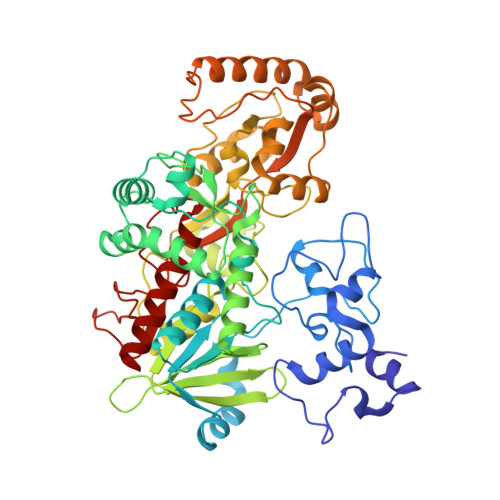Identification of the Active Site Acid/Base Catalyst in a Bacterial Fumarate Reductase: A Kinetic and Crystallographic Study
Doherty, M.K., Pealing, S.L., Miles, C.S., Moysey, R., Taylor, P., Walkinshaw, M.D., Reid, G.A., Chapman, S.K.(2000) Biochemistry 39: 10695
- PubMed: 10978153
- DOI: https://doi.org/10.1021/bi000871l
- Primary Citation of Related Structures:
1E39 - PubMed Abstract:
The active sites of respiratory fumarate reductases are highly conserved, indicating a common mechanism of action involving hydride and proton transfer. Evidence from the X-ray structures of substrate-bound fumarate reductases, including that for the enzyme from Shewanella frigidimarina [Taylor, P., Pealing, S. L., Reid, G. A., Chapman, S. K., and Walkinshaw, M. D. (1999) Nat. Struct. Biol. 6, 1108-1112], indicates that the substrate is well positioned to accept a hydride from N5 of the FAD. However, the identity of the proton donor has been the subject of recent debate and has been variously proposed to be (using numbering for the S. frigidimarina enzyme) His365, His504, and Arg402. We have used site-directed mutagenesis to examine the roles of these residues in the S. frigidimarina enzyme. The H365A and H504A mutant enzymes exhibited lower k(cat) values than the wild-type enzyme but only by factors of 3-15, depending on pH. This, coupled with the increase in K(m) observed for these enzymes, indicates that His365 and His504 are involved in Michaelis complex formation and are not essential catalytic residues. In fact, examination of the crystal structure of S. frigidimarina fumarate reductase has led to the proposal that Arg402 is the only plausible active site acid. Consistent with this proposal, we report that the R402A mutant enzyme has no detectable fumarate reductase activity. The crystal structure of the H365A mutant enzyme shows that, in addition to the replacement at position 365, there have been some adjustments in the positions of active site residues. In particular, the observed change in the orientation of the Arg402 side chain could account for the decrease in k(cat) seen with the H365A enzyme. These results demonstrate that an active site arginine and not a histidine residue is the proton donor for fumarate reduction.
- Department of Chemistry, University of Edinburgh, West Mains Road, Edinburgh EH9 3JJ, U.K.
Organizational Affiliation:





















